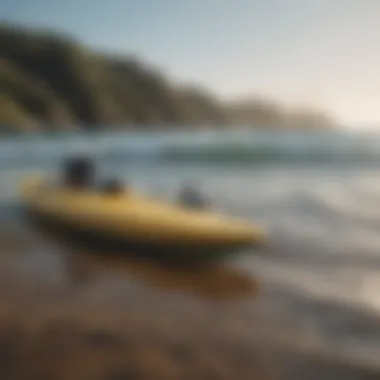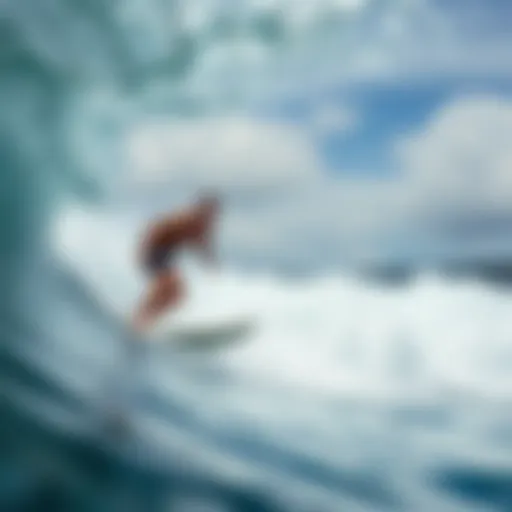Choosing the Right Size Paddle Board for Beginners


Intro
When it comes to paddle boarding, the first step can sometimes be the hardest. Breaking into this water sport is exciting, yet choosing the right size paddle board has its nuances. Selecting a paddle board isn’t just about picking one that looks nice or fits your budget. It plays a crucial role in your overall experience and can significantly impact your performance and enjoyment on the water.
Many factors influence the decision-making process, including your weight, height, skill level, and the type of activities you plan to pursue. Understanding these elements can seem overwhelming at first, but fear not; this guide aims to simplify it all for beginners. By gaining insights on stability, buoyancy, and maneuverability, you’ll be better equipped to make an informed choice, setting the stage for a more fulfilling paddle board experience.
From recreational paddling to yoga sessions on calm waters, the right board can make all the difference. Not only can it enhance your proficiency, but it also ensures safety. We’ll explore how diverse dimensions and shapes of paddle boards interact with these elements, guiding you to a selection tailored to your individual needs.
So, buckle up as we embark on an educational journey into the world of paddle board sizes, aiming to clarify any foggy areas and illuminate your path to becoming a confident paddler.
Understanding Paddle Board Sizes
Before diving into the specifics, it’s essential to explain what paddle board sizes mean. Paddle boards come in various lengths, widths, and thicknesses, with each dimension contributing to the overall performance and usability. In a nutshell, the size of the paddle board affects:
- Stability - A wider board generally offers better stability, making it ideal for beginners who are still finding their sea legs.
- Maneuverability - If your intent is to perform tricks or navigate tight turns, a narrower board may suit you better.
- Buoyancy - Heavier individuals may require a larger volume board to maintain buoyancy on the water.
Understanding these factors can take the stress out of choosing the right paddle board. Let’s move to our next section where we break down how your personal attributes play into the selection process.
Understanding Paddle Board Basics
Having a solid grasp on paddle board fundamentals is essential for anyone stepping into the world of paddle boarding. This section lays the groundwork for understanding how different elements, such as board types, materials, and sizing, affect your experience on the water. It’s more than just hopping on a board; your choice can make or break your enjoyment and performance.
Choosing the right paddle board isn’t a one-size-fits-all adventure. It perfectly integrates various facets, especially when you're just starting out. Grasping the core concepts aids in making informed decisions that align with your individual needs.
Defining Paddle Board Types
Before dipping your toes in, it's prudent to be aware of the different types of paddle boards available. Not all boards are cut from the same cloth; they come in diverse shapes and sizes tailored for various activities. Here’s a quick rundown:
- All-Around Boards: These are like the Swiss Army knives of paddle boards. Great for beginners due to their stability. They handle a little bit of everything: calm lakes, rivers, and even small waves.
- Touring Boards: If you plan to cover long distances, touring boards are designed for efficiency. Their narrow profile helps in slicing through the water while maintaining speed.
- Yoga Boards: Specifically designed for stability, these boards are wider, accommodating yoga postures without the risk of toppling over mid-downward dog.
- Racing Boards: Aimed at speed enthusiasts, these boards are sleek and narrow. They aren’t the best for beginners but are vital in the long-term mix if you're planning to compete.
Recognizing which type suits your needs can simplify your paddle boarding journey right from the start.
Materials and Construction
The materials and construction of a paddle board are more significant than one might think. Most boards are crafted from foam, plastic, or composites, each offering unique advantages.
- Epoxy/Plastic Boards: These boards are tough as nails, resistant to bumps, and highly buoyant. They are typically heavier but perfect for rough handling.
- Inflatable Boards: Increasingly popular due to their ease of transport, inflatable boards are lightweight and can fit into a backpack when deflated. However, they may lack some rigidity compared to solid boards.
Understanding these materials helps you align your choice with your paddling plans. A durable board can stand the test of time while providing a smooth ride, and knowing what you're dealing with pays off in the long run.
Importance of Size
Size might often be overlooked, but it significantly impacts your paddle boarding experience. A board that’s too small may feel tippy, while a board that’s overly large could be cumbersome to maneuver.
Factors such as your weight, height, and intended activity jump into play here. For novice paddlers, opting for a board that is buoyant enough to support your weight gives a stable introduction to the sport. Likewise, if you're taller, a longer board often provides a balanced ride.
It’s important to connect the dots between your personal physique and the board’s dimensions. Generally speaking, a longer board offers more speed and tracking, while shorter boards tend to be more maneuverable.
To sum it up:
- Boards for larger individuals or those looking for stability should consider wider, longer options.
- Trimming the size down might be appealing but ensure it aligns with your paddling goals.
Selecting the right size from the get-go not only cultivates confidence but also enhances your safety on the water. It directly affects not just performance but overall enjoyment.
"A well-chosen paddle board can be like a trusty steed; it carries you through highs and lows while you explore new horizons."
Understanding these basics provides a framework to make well-informed choices in your paddle boarding experience. Armed with this knowledge, the road ahead can take on an entirely new dimension.
Factors Influencing Paddle Board Size
Selecting the right size paddle board is like choosing the right pair of shoes—if they don't fit well, you won't enjoy the experience. The importance of understanding the factors that influence paddle board size cannot be overstated, especially for those just stepping foot into the world of paddle boarding. The wrong size board can hinder performance, reduce stability, and, ultimately, make the experience less enjoyable.
In this section, we will dive into the primary elements that affect paddle board sizing: the paddler's weight, height, skill level, and intended use. Each of these factors contributes to how a board performs and feels on the water. A beginner who takes the time to understand these components will be in a much better position to select a board that enhances their paddling experience.
Paddler's Weight


Weight plays a vital role in determining the appropriate paddle board size. Every board has a weight capacity, and exceeding it can lead to a slippery slope of troubles. When a paddler's weight is significantly less than the board's recommended limit, stability may be compromised. Conversely, if the paddler's weight surpasses the board's capacity, it can sink—definitely not ideal.
For instance, an individual weighing around 160 pounds might benefit from a board length of 10'6" to 11'0" and a width of about 30 inches for optimal stability. Knowing your weight range against the board specifications will help you choose wisely. A smart rule of thumb is to pick a board that can support at least 50 pounds more than your body weight. This cushion allows for any gear or additional weight you might bring along.
Paddler's Height
Another significant influence on paddle board sizing is a paddler's height. Taller paddlers often require longer boards to ensure a comfortable paddling stance. A longer paddle board helps distribute weight evenly while maintaining balance, which is essential for beginners still developing their skills.
Let’s say you’re 6 feet tall; opting for a board that’s at least 11'0" will ensure you have better leverage and stability. In contrast, shorter individuals may find a board between 9'6" and 10'6" more appropriate. This consideration means they are less likely to struggle with stability or feel unbalanced.
Skill Level
Your level of experience also plays a pivotal role when it comes to choosing a paddle board size. Beginners typically fare better on wider boards that offer increased stability, allowing for easier balance while paddling. On the other hand, more skilled paddlers might prefer narrower boards that provide enhanced speed and maneuverability.
For individuals just starting out, boards that are 30 inches wide or more contribute significantly to stability. As skills develop, they may transition to narrower boards that allow for quicker turning and performance.
Intended Use
Finally, one must consider what they plan to do on that paddle board. Different activities call for different sizes. If your intention is leisurely paddling on calm lakes, a wider, more stable board will suit you well. For those who fancy a bit of challenge and want to embark on long distance tours, a longer and narrower board may fit the bill.
"Before you buy, think about how you'll use the board. It can save you a lot of headaches later on."
When choosing a size, consider whether you’ll primarily paddle in flat water, surf waves, or practice yoga. Each of these activities has specific board sizes and designs that align best with their purpose.
Taking the time to assess these four factors—weight, height, skill level, and intended use—can make a world of difference in your paddle boarding journey. The right board not only enhances your benefits on the water but also ensures you enjoy every moment spent mastering this lovely sport.
Recommended Sizes for Specific Activities
Finding the right size paddle board can feel like searching for a needle in a haystack, especially for beginners. The sizes are not just numbers on a chart; they represent a myriad of factors that influence how you paddle and enjoy your time on the water. Understanding the recommended sizes for specific activities is essential. It helps you choose wisely and get the best performance based on your intended use, which ultimately enriches your paddle boarding experience. Thinking about activities like recreational paddling, yoga, touring, or even racing will guide you to select a board that responds best to your specific needs, ensuring enjoyment and safety.
Recreational Paddling
When it comes to recreational paddling, the focus is on fun and relaxation. Boards in the range of 10 to 12 feet often hit the sweet spot for most casual users. A board around 10'6" provides a nice blend of stability and ease of maneuverability, making it perfect for flat-water paddling. The wider boards, usually around 32 inches, deliver extra stability which is particularly beneficial for first-timers still finding their balance.
Thinking about transportation? It’s best to check the board��’s weight. Lighter boards can often be carried around without feeling like you’re lugging a ton of bricks. So, for leisurely afternoon excursions or a quick jaunt to a nearby cove, select a board that feels comfortable under your arm while providing ample stability on the water.
Yoga on Paddle Boards
Yoga enthusiasts have specific needs that differ from those who just want to paddle around. Stability is paramount as you flow through poses and soak up the scenery around you. Generally, a board that’s 32 inches wide or more is ideal. It allows for solid footing and helps maintain balance as you move and transition between poses.
Length matters too—boards ranging from 10 to 12 feet are commonly recommended. They create enough space for you to stretch out without feeling cramped. It’s worth noting that a larger surface area means enhanced stability. When contemplating a paddle board for yoga, consider features like non-slip decks that can keep you securely in place even when the water has a bit of a chop.
Touring and Expeditioning
For those looking to venture into more adventurous waters, touring and expedition paddle boards present a different set of requirements. Boards that stretch from 12 to 14 feet are generally preferred. The longer length improves tracking and allows paddlers to cover more distance with less effort—great for day trips or longer adventures.
Width is still a factor, but leaner boards around 28-30 inches offer speed and agility. When planning for a trip, don't forget the capacity to carry gear; look for boards designed to handle additional weight without compromising performance on the water. It's key to find a board that supports a lighter stroke while giving you confidence in stability—especially if you’re loading it up with overnight gear or provisions.
Racing
Racing is where efficiency and speed reign supreme. For a beginner looking to take part in races, boards that are 14 to 16 feet long become an asset. Their length aids in cutting through water, enabling faster speeds, though it takes a bit of time to master paddling efficiency on these boards.
The width often shrinks down to around 25 to 28 inches. This slimmer design provides less drag, facilitating quicker movements. However, it does come with a trade-off in stability, which can be a hurdle for novice racers. Those who plan to dabble in competitive paddling should look for boards with a narrow, pointed nose; this design contributes to speed while reducing resistance against water currents.
"Finding the right board size is non-negotiable for maximizing your experience—whether you are serenely paddling through a lake or slicing through waves in a race."
Grasping the unique demands of each specific activity will assure that you choose a paddle board tailored to your aspirations on the water. Whether you're looking to unwind with yoga or test your skills in a race, there’s a perfect board out there waiting for you.
Stability and Buoyancy Considerations
When it comes to paddle boarding, especially for beginners, understanding stability and buoyancy is paramount. These two elements play a crucial role in the overall paddling experience. Novices often encounter challenges when trying to balance on the board, and knowing how stability and buoyancy interact can help avoid many slip-ups.
Understanding Stability
Stability in paddle boarding can be dissected into two types: lateral and longitudinal stability. Lateral stability is what keeps the paddle board from tipping over side to side. Longitudinal stability refers to how the board maintains its position as you move forward. A stable board will provide more confidence for beginners, and choosing the right size is a significant factor in achieving that.


- Board Width: A wider board typically offers better stability. If your board is too narrow for your size or skill level, it will feel wobbly and increase the risk of falls. Beginners generally find a board that is at least 30 inches wide to be more forgiving.
- Board Roundedness: The shape of the paddle board's hull also matters. Boards with a rounder hull tend to be more stable in calm waters, making them suitable for leisurely paddling.
- Paddler Positioning: Where you stand on the board is another aspect of stability. Ideally, standing between the center and slightly up towards the nose helps maintain balance without oversteering.
Buoyancy and Weight Distribution
Buoyancy is described as the upward force that counteracts weight. In paddle boards, the more buoyant the board, the less likely a paddler is to submerge it. Weight distribution on the board also affects how buoyant it feels, especially when factoring in different paddler sizes.
- Material Choices: Boards made from inflatable materials or epoxy can vary in buoyancy levels. Inflatable boards often provide more buoyancy due to the air-filled construction, which can be particularly advantageous for beginners who may need that extra lift.
- Weight Capacity: Each paddle board comes with a weight capacity. It’s essential to check this and select a board that can accommodate both your weight and any additional gear. Overloading a board can lead to instability and may submerge the tail portion of the board, making it difficult to navigate.
- Positioning Gear: When carrying extra gear, distribute its weight evenly. This consistency helps maintain buoyancy throughout the entire board. Avoid piling everything on one side or towards the front, as that can throw off your balance.
"Choosing the right paddle board based on stability and buoyancy not only enhances your performance but also builds your confidence as a paddler."
In summary, stability and buoyancy considerations are vital when selecting a paddle board. For beginners, grasping these elements helps to ensure a safe and enjoyable experience on the water.
Maneuverability and Performance
When it comes to paddle boarding, maneuverability and performance play a pivotal role in how enjoyable and effective your experience will be. For beginners especially, understanding these concepts can make a world of difference. Without the ability to gracefully turn or speed across the water, even the most luxurious paddle board can feel like a clunky piece of wood. Thus, a well-sized paddle board not only enhances stability but also boosts maneuverability and performance.
Turning Radius
Turning radius refers to how easily and quickly a paddle board can change direction. This becomes particularly significant in crowded areas or when navigating around obstacles like rocks and buoys. If a board has a tight turning radius, it will require less effort and time to maneuver.
- Shorter Boards: Typically, shorter boards have a smaller turning radius. This means they can pivot quickly and elegantly, making them ideal for beginners who might need to change direction often as they learn.
- Longer Boards: While longer boards provide better straight-line speed and stability, they tend to have a larger turning radius. This could be a challenge for beginners who may not yet have the experience to manage these longer boards in tight spaces.
It's worth noting that if you're leaning towards touring or racing, where straight speed matters, a board with a larger footprint would be appropriate. But for leisurely paddling or yoga, a tighter turning radius could really make a difference.
Speed Considerations
Speed is another aspect where the size and shape of the paddle board come into play. Generally, longer boards are designed for greater speed due to their slim profile. However, speed isn’t everything for beginners; balance, control, and the overall feel come into the mix here as well.
- Length and Width: Longer boards with a narrow width cut through waves and allow for a faster glide. But for a newcomer still getting a hang of balance, this could be a tougher ride.
- Board Shape: The shape of the board also matters. A pointed nose (or bow) will easily slice through water, improving speed, while a wider tail can provide stability, which is more crucial for learning.
- Wave Conditions: Beginners should always take into account the conditions they plan to paddle in. If you're headed for choppy waters, a stable board that sacrifices some speed might serve you better than one designed purely for optimal speeds.
Consider your paddling environment before making decisions. A board that works well in calm lakes might not perform as nicely in ocean swells.
Effectively balancing these aspects—turning radius and speed—leads to a tailored paddle boarding experience that not only feels the best but also enhances the learning curve. Always remember to take your time testing different boards to find out what suits your needs, as every paddler has their unique style and preferences.
Choosing Your First Paddle Board
Selecting your first paddle board is like trying to find the right pair of shoes – it needs to fit just right, or you might end up with blisters instead of fun. This crucial step helps both current and potential paddlers avoid pitfalls that can make the first experience less enjoyable. Making the right choice fosters confidence and increases the likelihood of sticking with the sport. After all, who wants to spend their first outing struggling to balance or maneuver while others glide effortlessly around them?
First-time buyers should consider not just their physical size but also the goals they have in mind for paddle boarding. Whether it's a peaceful afternoon on a lake, practicing yoga by the beach, or racing along the coast, these diverse perspectives can shape one’s choice of board significantly.
Assessing Your Needs
Before diving into the options on the market, it's paramount to sit down and think about what you truly need from a paddle board. Ask yourself the following questions:
- What is my weight?
Your body weight has a big say in which board will work best for you. Heavier individuals typically require larger boards to ensure buoyancy and stability. - How tall am I?
Height will affect your center of gravity – shorter paddlers might find that a narrower board suits them better than a larger one. - What activities do I want to do?
Are you looking to stroll across calm waters, or do you want to surf some waves? Your interests can influence whether you lean towards a recreational board or something more specialized. - What's my budget?
Understandably, the cost can sway your decision. Paddle boards range from budget-friendly to luxury options. Consider compromising on features rather than board size if you’re financially restricted.
Taking time to answer these questions allows prospective paddlers to narrow down their choices significantly, saving both time and effort in the long run.
Testing Various Sizes
Once you've assessed your needs, it's wise to get a hands-on experience before making a purchase. This is where trying out different sizes comes into play, and it can really be a game-changer.
Visit Local Shops:
Many paddleboarding shops and rental companies offer demos, so you're not just tossing your money at a board that might not fit your needs. Testing boards helps determine what feels right based on the way you balance, paddle, and maneuver.
Ask Questions:
Don't hesitate to ask experienced staff about which size they recommend for your preferences or the type of paddling you plan to do. Often, they might share valuable insights you hadn’t considered.
Multiples Sizes at Once:
If you can, try more than one board in a single visit. Switching from one size to another helps highlight differences in stability and ease of steering. You might find surprising revelations that steer you toward a specific board type.
Mock Scenarios:
Before making your final call, picture yourself actually using the paddle board in various scenarios. How would it respond to turning? What’s the stability like when you’re trying to balance?
In essence, treating the experience as a real test run enhances understanding and can prevent a misstep that could sour the enjoyment of a potentially thrilling sport.
"The best paddle board is the one that complements your individual experience rather than complicating it."
Through thoughtful evaluation of personal needs and practical exploration of options, beginner paddlers can feel assured in their selection of their first paddle board, setting the stage for a fulfilling journey ahead.


Common Mistakes to Avoid
Choosing the right paddle board, especially as a beginner, can be a daunting task. However, avoiding some common pitfalls can make all the differnce in your paddleboarding experience. These mistakes often stem from a lack of understanding or research, and can lead to frustration or, worse, an unsafe experience on the water. Here we explore two primary mistakes to be aware of: overestimating one's skill level and ignoring the environmental factors.
Overestimating Skill Level
One significant error that many novices make is assuming they possess more skills than they actually do. Just because you’ve taken a few lessons or watched some videos online does not mean you’re ready for advanced maneuvers or challenging water conditions. The reality is, paddleboarding, like many outdoor sports, requires a blend of physical coordination, balance, and situational awareness.
When a beginner opts for a smaller or more advanced board because they believe they are more capable, they can quickly find themselves in a precarious position. A board that is too small lacks the stability needed for those just starting out, leading to frequent falls and potential injury. Moreover, urging oneself to tackle swift currents or waves without the proper experience can turn fun into peril.
To avoid this trap, be honest with yourself about your current skill level. If you’re unaccustomed to paddleboarding, a wider, more stable board is likely your best bet. As the adage goes, "You should crawl before you can walk.” Start simple, learn the basics, and gradually increase your challenges as your skills improve.
Ignoring Environmental Factors
Another common oversight is not taking the environmental conditions into consideration. Water conditions can drastically change from one moment to the next, influenced by tide shifts, wind patterns, or weather changes. A beginner focusing solely on the board selection may overlook how these factors play a crucial role in their paddling experience.
For instance, paddling in a calm lake on a sunny day is much different from taking on turbulent ocean waves or a windy river. Underestimating those conditions might make you feel overconfident. Moreover, specific boards are designed for certain environments — a surf paddle board is quite different from one meant for flatwater touring. The wrong board in the wrong conditions can not only hinder performance but could also bring about dangerous scenarios.
To help prevent this error:
- Check the weather and water conditions before heading out.
- Identify your local waterways and their characteristics.
- Talk to local paddlers or shops about what’s ideal for beginners in those conditions.
In summary, steering clear of these common mistakes can enhance your paddleboarding journey. By staying grounded about your skill level and paying close attention to your surroundings, you will likely have a safer, more enjoyable experience on the water.
Maintenance and Care for Your Paddle Board
Taking care of your paddle board isn’t just a chore; it’s a part of ensuring it serves you well through many outings on the water. Proper maintenance can prolong the board's lifespan and enhance your overall experience, especially if you are a beginner learning the ropes of paddle boarding. It might seem straightforward, but every board has its own nuances that require attention.
It's more than just cleaning; it’s about knowing how to handle your board so that every trip to the water is as fresh as the first one. Here are the key elements to consider in your maintenance journey:
- Preserves board integrity
- Ensures safety while paddling
- Optimizes performance
A well maintained paddle board not only looks good but also handles better on the water. You gain peace of mind by knowing that your gear is in top-notch condition, allowing you to focus on the beautiful experience of paddling.
Cleaning and Storage Tips
Cleaning a paddle board is not rocket science, yet many novices overlook this crucial aspect. After a session on the water, it’s tempting to toss the board aside and call it a day. However, regular cleaning plays a significant role in the board’s longevity.
Here’s how to do it right:
- Rinse with fresh water: After every use, especially in saltwater or heavily chlorinated water, give your board a good rinse. This prevents salt or chlorine buildup, which can damage the board over time.
- Use mild soap: For a deeper clean, a mild soap or specifically designed board cleaner works wonders. Avoid harsh chemicals that can strip the board's finish.
- Soft cloth or sponge: While it's tempting to use abrasive scrubbing pads, stick with a soft cloth or sponge to avoid scratches on the surface.
- Dry it off: Once clean, dry your board thoroughly before storing it. This reduces the risk of mildew or mold, especially if it's been exposed to moisture.
When it comes to storage, choosing the right spot is half the battle. Avoid keeping it in direct sunlight for extended periods, as this can warp or fade the colors.
Store your paddle board in a cool, dry place, ideally, on a rack or wall mount to keep it safe from extreme temperatures and moisture.
Regular Inspections
Just like checking a car for maintenance, regular inspections of your paddle board can prevent minor issues from escalating into major headaches. Spend a little time every few weeks looking over your board.
Look out for:
- Dents or dings: Any noticeable damage can compromise the board's performance. A small ding can lead to more significant issues if left untreated.
- Leaks: Especially if you have an inflatable board, be sure to inspect for leaks periodically. Filling the board and checking for air loss can save you from surprise deflation on the water.
- Fins and leash: Ensure that your fins are securely attached and that your leash hasn’t seen better days. A broken leash can turn what might be a minor tumble into a risky situation.
Taking these steps keeps your paddle board in prime condition. The extra effort now can significantly pay off in smoother rides and enhanced enjoyment in your water adventures.
Ending
Choosing the right size paddle board is more than just picking a board that looks nice or is recommended by a friend. It’s a decision that can significantly influence your experience on the water. A board that fits poorly can lead to discomfort or even discourage a novice paddler from pursuing the sport further. When making this decision, it’s crucial first to understand the fundamental elements that determine how a board will perform based on individual needs.
Let’s break down what should be taken into account. Firstly, consider personal attributes, such as weight and height. These factors have a direct impact on stability and buoyancy, ensuring that the board can support you adequately while in action. Furthermore, the type of activities you plan on engaging in plays a pivotal role as well. For instance, a racing enthusiast will have different requirements than someone interested in yoga on water. By aligning your paddle board choice with your intended use, you enhance both performance and enjoyment.
Moreover, skill level cannot be overlooked. Beginners often feel more secure on wider, larger boards that provide better stability, compared to those who are more experienced and may thrive on nimble, shorter boards. Understanding your comfort level with balance, speed, and maneuverability will aid in selecting a board that complements your journey from novice to pro.
"Each paddler's experience is unique, much like each paddle board. Finding the right fit makes the ride memorable."
Final Thoughts on Size Selection
When zeroing in on size selection, reflect on the foundational principles discussed throughout this article. There’s a world of difference between selecting a board based merely on price or aesthetic appeal and choosing one that fits your unique situation. Engaging with paddle board communities or seeking advice from instructors can bridge the gap between confusion and clarity.
Additionally, ensure to test ride different sizes before making a decision. Every board offers a different feel, and often, what may seem right on paper could differ once you're afloat. This hands-on approach will guide you to discover what works best for you, leading to a rewarding paddle board adventure.
Ultimately, paddle boarding should bring joy, relaxation, and excitement. Keep these considerations at the forefront of your mind as you embark on your paddle boarding journey. Picking the right board sets the stage for unforgettable memories and opportunities to connect with the water.















